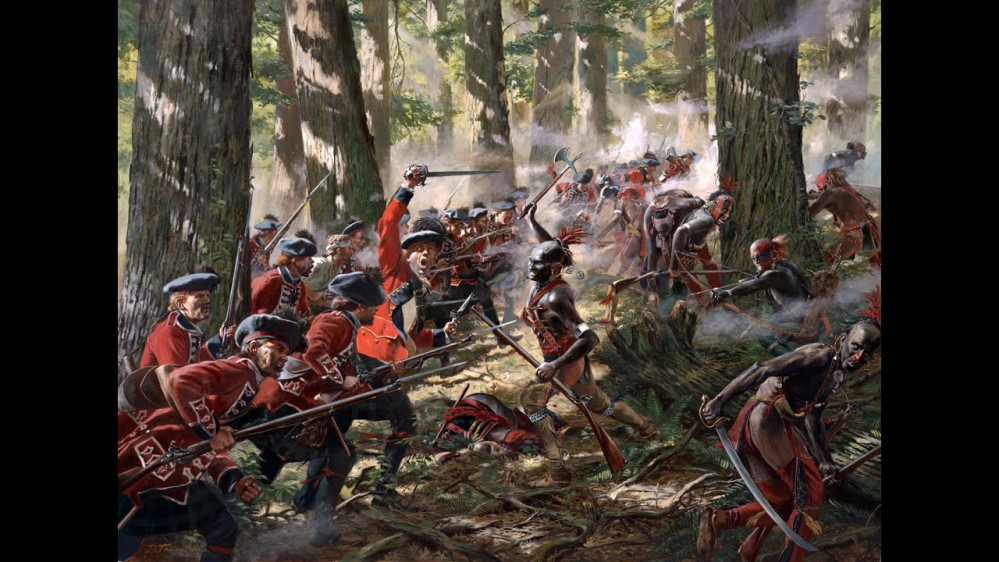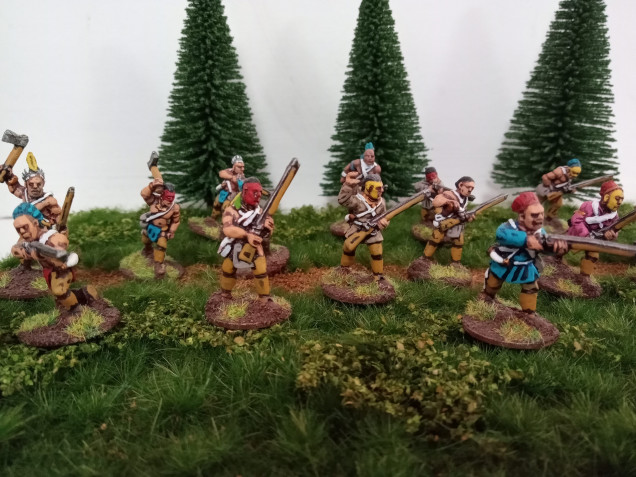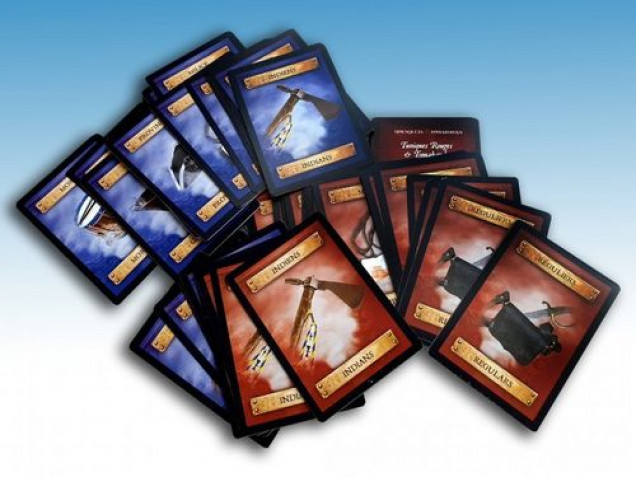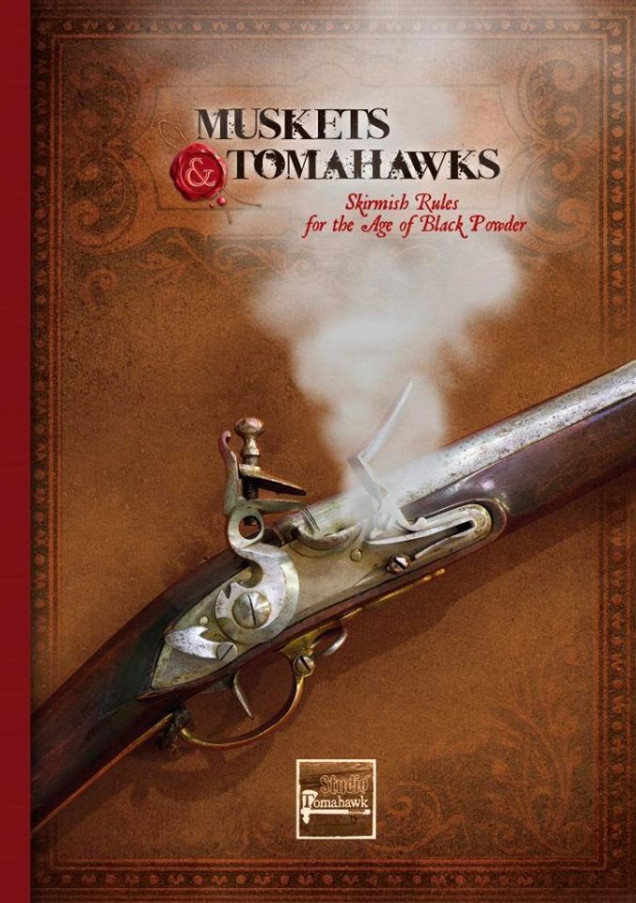
A Gentleman's (or Woman's) Guide to Recreating the Engagements that Took Place in North America During the French and Indian War with Special Attention Given to those Small Skirmishes Well Suited for 28mm Tabletops
The Basics
The game is set out with a core rulebook covering the basic rules of the game and expansions that provide the players with army lists, scenarios and other colourful touches that add a period feel to the game. At the moment there is only a single expansion, Muskets and Redcoats, which covers the French and Indian War, The American Revolution and the War of 1812 which were all in the first edition of the game. Also included in the rulebook are pictures of Napoleonics, Indian Mutiny, American Civil War, Zulu Wars, Mahdist War, The Opium Wars and The Northwest Frontier to give everyone a taste of what is to come.
In this article we’ll take a look at the basic mechanics of the game, in the next we’ll look at how to set up and play a game and in the final article we’ll look at how to build a list for your games and take a look at all the different types of units.
After the players have built their lists they select the cards they will need, if you are playing as the British and have Regulars, Indians and Irregulars in your force then you will place the British Regulars, Indians and Irregulars cards into the shared deck. After both players have put their cards into the shared deck some extra cards are added (we’ll get to them later) the deck is shuffled and each player is dealt three cards.
The game is card driven and rather than having turns the players alternate playing a card from their hand. For example the British player plays a British Regulars card which means all of their Regular units get to take as many actions as the cards allows them, generally one or two.
A new addition to the game are Command Points which are mostly earned by playing the oppositions cards, for example our British player deals a French Regulars card. This means all of the French Regular troops get to take as many actions as the card allows. However since the player played a card belonging to their opponent they get a command point.
 This Period has something for every painter from drab Rangers to colourful Indians. From Uniforms to Civilian Clothing. All figures in this article are from my own collection.
This Period has something for every painter from drab Rangers to colourful Indians. From Uniforms to Civilian Clothing. All figures in this article are from my own collection.That’s how units get the chance to activate but what type of activation’s can they do? Of course there are the basics, moving, shooting, charging but there are also two new actions.
Vigilance for example lets a unit take up an over watch position meaning they ‘bank’ their shooting activation for later in the turn.
Reloading is pretty straightforward it allows the player to reload their troops however it is worth mentioning since the shooting itself has changed. In the new edition rather than the entire unit firing at once and getting a reload marker now half the unit can fire and not get a reload marker.
Speaking of shooting before a unit can shoot at another unit it first has to spot them. Spotting is not a new concept for Muskets and Tomahawks but it was a largely ignored rule due to how complicated it was and how pointless it often was. In the new edition the spotting chart has all been merged into a single easy to read chart. All units can be seen in the open from 96 inches away however things like terrain, enemy unit type and the weather can make it harder to see the enemy while things like whether or not the enemy has fired or what type of troops the spotting unit is make it easier to see.
For example a unit of British Regular are 20 inches away from a unit of Indians in a dense wood. They can normally see them from 96 inches away in the open but have to reduce that distance by three columns due to dense terrain making the spotting range 24 inches however this isn’t the end as the Indians are classified as ‘Natives’ and add another penalty to the spotting column making the spotting range 18 inches meaning the British Regulars cannot fire at them since they can’t see them.
Another new addition is the dice, instead of being the normal d6 Muskets and Tomahawks has changed to a d10 system with the lowest result being a 0 and the highest being a 9.
Shooting penalties effect your ability to hit such as range, cover, formation and type of unit shooting. Before firing select as how many figures will shoot and pick up that many dice, then check the unit can spot their target, check the range of their weapons and only then can you roll the dice. Every unit has a shoot value which you have to roll higher than to score a hit, this value can be modified up or down depending on terrain and range. After hitting the player then rolls against the strength value of the weapon and every roll that scores higher than this value causes a casualty.
As you might expect having your friends shot around you can get on your nerves. After a unit takes any casualties, is hit at least three times or is targeted by volley fire the controlling player rolls on a chart, applying modifiers like nearby officers, unit formation, number of figures killed and more. Different unit types have different charts, Regulars will be much more likely to stick around than basic Militia who in turn are more reliable than raw civilians.
Close combat is essentially the melee version of shooting and not worth it’s own explanation here.
We mentioned Command Points earlier in the article so let’s finish by taking a deeper look at them. As mentioned earlier the most common way to earn Command points is to play your opponents troop cards, the other ways are too specific to mention here. A player has a limit of 10 Command points at any time. Let’s take a look at the abilities you can use with Command points.
Hark: Put a unit on Vigilance/Over watch.
Hold Back: Take a card in your hand, place it face down and use it at any time.
Stand Fast: Automatically Rally a fleeing unit.
Order: Take an action with a unit of your choice, the cost depends on how large the unit is.
Preparation: Take a card from the discard pile and return it to your hand.
Thanks for reading the first article on the 2nd Edition of Muskets and Tomahawks hopefully you’ll now have a better grasp of how the rules work, the style of the game and any changes since the first edition you might be familiar with.































![TerrainFest 2024 Begins! Build Terrain With OnTableTop & Win A £300 Prize! [Extended!]](https://images.beastsofwar.com/2024/10/TerrainFEST-2024-Social-Media-Post-Square-225-127.jpg)













































Leave a Reply